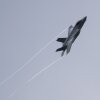
British Prime Minister Keir Starmer (center) and Britain’s Defence Secretary John Healey (right) meet with BAE system apprentices as they look at a submarine model during a joint visit on March 20 in Barrow-in-Furness, United Kingdom. Starmer says the U.K. must upgrade its military in response to threats from Russia. WPA Pool/Getty Images hide caption
toggle caption
WPA Pool/Getty Images
In a stark report this week, British Prime Minister Keir Starmer proposed the largest increase in defense spending since the Cold War, warning that the U.K. must be prepared to fight a war in Europe at any time. The move marks the latest shift in defense posture for a NATO member since the start of the war in Ukraine.
Announcing the 2025 Strategic Defence Review on Monday, the prime minister said the U.K. must move toward “war-fighting readiness.”
Starmer, who has for months made no secret of his desire to increase spending on the military, vowed to create “a battle-ready, armor-clad nation.” He said Britain “cannot ignore the threat that Russia poses.”
“The threat we face is more serious, more immediate and more unpredictable than at any time since the Cold War,” said Starmer, who leads Britain’s center-left government.
The review puts Britain in good company among its European-based NATO allies. Notably, Poland and Germany are moving in a similar direction — aiming to transform their militaries to meet the challenge presented by Russia in the wake of its 2022 full-scale invasion of Ukraine.

Ukraine invasion — explained
Trump promised peace in Ukraine within a day. Here’s what actually happened
Since then, Warsaw has boosted its defense spending from 2.7% of GDP to 4.2% in 2024 — a figure expected to rise to 4.7% in 2025, according to NATO. Likewise, Germany has increased overall defense spending from 1.38% of GDP at the time of the Russian invasion of Ukraine to 2% of GDP in 2024. Last year, German Defense Minister Boris Pistorius said that further increases were expected. Russian President Vladimir “Putin’s war economy is working towards another conflict,” Pistorius said, speaking in October. “We must be ready for war by 2029. We need a deterrent to stop the very worst from happening.”

A Polish serviceman stands on an Abrams M1A1 tank during the 2024 International Defence Industry Exhibition in Kielce, Poland, on Sept. 3, 2024. Poland and Germany are among the countries aiming to transform their militaries to meet the challenge presented by Russia. Sergei Gapon/AFP via Getty Images hide caption
toggle caption
Sergei Gapon/AFP via Getty Images

State of the World from NPR
Poland Prepares for War
Malcolm Chalmers, deputy director general of the Royal United Services Institute (RUSI) think tank in London, describes the transformation in Germany’s military thinking from just a few years ago as “quite remarkable.” In the case of the U.K., it “would have been inconceivable” before Russia’s full-scale invasion of Ukraine, he says.
Uncertainty about Trump is another factor at play
While these actions by key NATO members are explicitly a response to growing security threats from Russia, some experts highlight another underlying factor: the Trump administration’s confrontational approach to the alliance and the president’s echoing of Kremlin narratives about the origins and implications of the war in Ukraine.
To some, the shift may vindicate Trump’s America First strategy — a sign that pressuring allies to increase defense spending is working. To others, it signals a more troubling possibility: that Washington’s long-standing guarantee to defend Europe may no longer be assured in the face of a major conflict.
“There is a sense that the Trump administration is an unpredictable ally,” says Phil Dickinson, deputy director of the Transatlantic Security Initiative at the Atlantic Council and a former British diplomat. In addition, he says, there is a “widespread acknowledgment and acceptance that we are in a different geopolitical era … whilst we might not be directly at war, we’re certainly no longer at peace.”
Chalmers believes that the content of the U.K. defense plan is “shaped by Donald Trump’s return to the U.S. presidency.”
“The reason why the Europeans need to do more on defense is not primarily to persuade the United States to stay — it’s to prepare for the possibility that the U.S. may leave,” he says.

World
5 signs that a U.S.-Europe split is widening
What’s in the U.K. defense plan
If approved by Parliament, the U.K. plan would boost defense spending from 2.3% of GDP to 2.5% by 2027, with a goal of reaching 3% of GDP in the next parliamentary term. That includes spending an estimated 68 billion pounds ($92 billion) on modernizing the military. The review says London’s aim is to take a leading role in NATO by bolstering its nuclear forces and improving military technology, while taking lessons from the war in Ukraine by innovating in drones and digital warfare.
A central element of the plan is the development of a “hybrid navy,” featuring up to a dozen new nuclear attack submarines, advanced warships and support vessels, upgraded aircraft carriers, and autonomous patrol ships for operations in the North Atlantic and beyond.
It also calls for the Royal Air Force to begin development of a “sixth-generation” crewed fighter jet capable of operating in tandem with drones — similar in concept to plans the Trump administration recently announced for the F-47. The U.K. would also build up to 7,000 new long-range weapons “to provide greater European deterrence,” the plan says.

World
Trump’s handling of Ukraine and tariffs has NATO rethinking the U.S.-made F-35 fighter
The review also addresses the shrinking British Army, which now has just over 70,000 combat-ready soldiers — less than half its strength at the end of the Cold War. The proposal includes a modest increase in active-duty personnel, bolstered by a revitalized Reserve force. The move is meant as “a tech refresh of the military,” rather than a huge increase in personnel or equipment, says Keir Giles, a Russia expert at Chatham House, a London-based think tank.
To sustain operations, the U.K. will also establish six new factories to create a continuous, “always on” supply line for munitions.
The broader strategy also seeks to drive economic growth through industry partnerships and major procurement overhauls — a “defense dividend,” in the words of Prime Minister Starmer.
“The review takes a holistic view of defense and in particular looks to reinvigorate the U.K.’s defense industry, which, like the armed forces, has atrophied over decades,” Giles says.
The plan is likely to be approved by Parliament, as Starmer’s Labour Party government has already said it would accept all 62 recommendations contained in the defense review.












